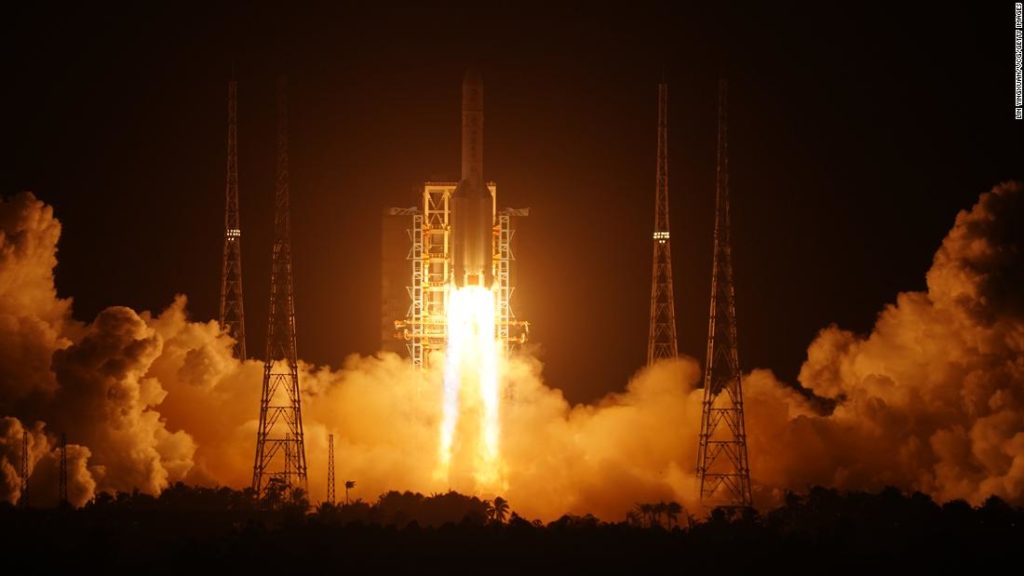The unmanned Chang’e-5 probe, named after the mythical Chinese goddess of the moon, blasted off from the Wenchang Spacecraft Launch Site in Hainan, near the country’s southern tip, in the early morning.
Once in the moon’s orbit, the probe will deploy a pair of vehicles to the surface to drill into the ground and collect soil and rock samples.
If successful, the mission will make China only the third country to have retrieved lunar samples, following the United States and the Soviet Union decades ago.
US astronauts brought back 382 kilograms (842 pounds) of rocks and soil during the Apollo program, between 1969 and 1972, while the Soviet Union collected 170.1 grams (6 ounces) of samples in 1976.
In the decades since, data from orbital remote sensing missions has shown there is a much greater diversity of rock types and ages on the moon than existing samples suggest.
These samples could help scientists understand more about the moon’s origins and foundations — and set the foundation for more complex sample retrieval missions in the future, potentially on other planets.
A month-long mission
Within 48 hours of the lander-ascender’s touchdown, its robotic arm will scoop up rocks from the surface, and a drill will bore into the ground to collect soil. The samples will be sealed into a container in the spacecraft.
The ascender will then take off, re-enter orbit, and dock with the orbiter-returner. At that stage, the samples will be transferred to the returner, and the ascender will separate, leaving the orbiter-returner to start the journey back to Earth. The returner will eventually separate, re-enter our atmosphere, and land in China.
From start to finish, the mission will last more than 20 days, according to Xinhua.
When the samples are returned to Earth, scientists will be able to analyze the structure, physical properties, and material composition of the moon’s soil, the CNSA said. The mission may help answer questions such as how long the moon remained volcanically active in its interior, and when its magnetic field — key to protecting any form of life from the sun’s radiation — dissipated.
“Unmanned rendezvous and docking in lunar orbit will be a historic first. It will be very difficult,” said Peng Jing, deputy chief designer of the probe, in the Xinhua report. “We could call it a milestone mission. Its success will help us acquire the basic capabilities for future deep space exploration such as sampling and takeoff from Mars, asteroids and other celestial bodies.”
China’s space ambitions
China was late to the space race — it didn’t send its first satellite into orbit until 1970, by which time the US had already landed an astronaut on the moon — but it has caught up fast.
Buoyed by billions of dollars in government investment, China has rapidly accelerated its space program over the past decade, firing space labs and satellites into orbit.
Speaking to astronauts aboard the Shenzhou 10 spacecraft by video link in 2013, Chinese President Xi Jinping said, “the space dream is part of the dream to make China stronger.”
“The Chinese people will take bigger strides to explore further into the space,” he added.
Last year, China became the first country to send an unmanned rover to the far side of the moon. And in July this year, China launched its first unmanned mission to Mars — the Tianwen-1 probe, which will orbit the planet before landing a rover on the surface. It’s expected to reach the Red Planet next February.
If Tianwen-1 is successful, Beijing has plans to eventually send a manned mission to Mars. Plans are also underway to launch a permanent space station by 2022, and send astronauts to the moon by the 2030s.
If successful, China would become only the second country, after the US, to put a citizen on the moon.
CNN’s James Griffiths contributed to this report.
You may also like
-
UK coronavirus variant has been reported in 86 countries, WHO says
-
NASA technology can help save whale sharks says Australian marine biologist and ECOCEAN founder, Brad Norman
-
California Twentynine Palms: Explosives are missing from the nation’s largest Marine Corps base and an investigation is underway
-
Trump unhappy with his impeachment attorney’s performance, sources say
-
Lunar New Year 2021: Ushering in the Year of the Ox

